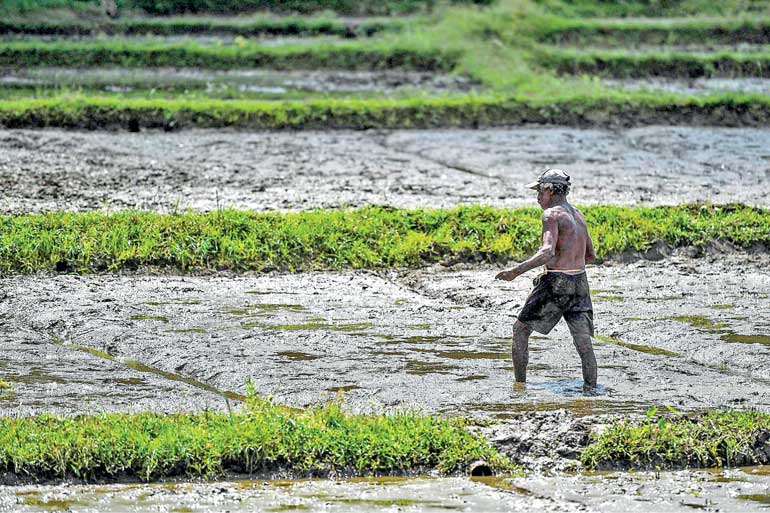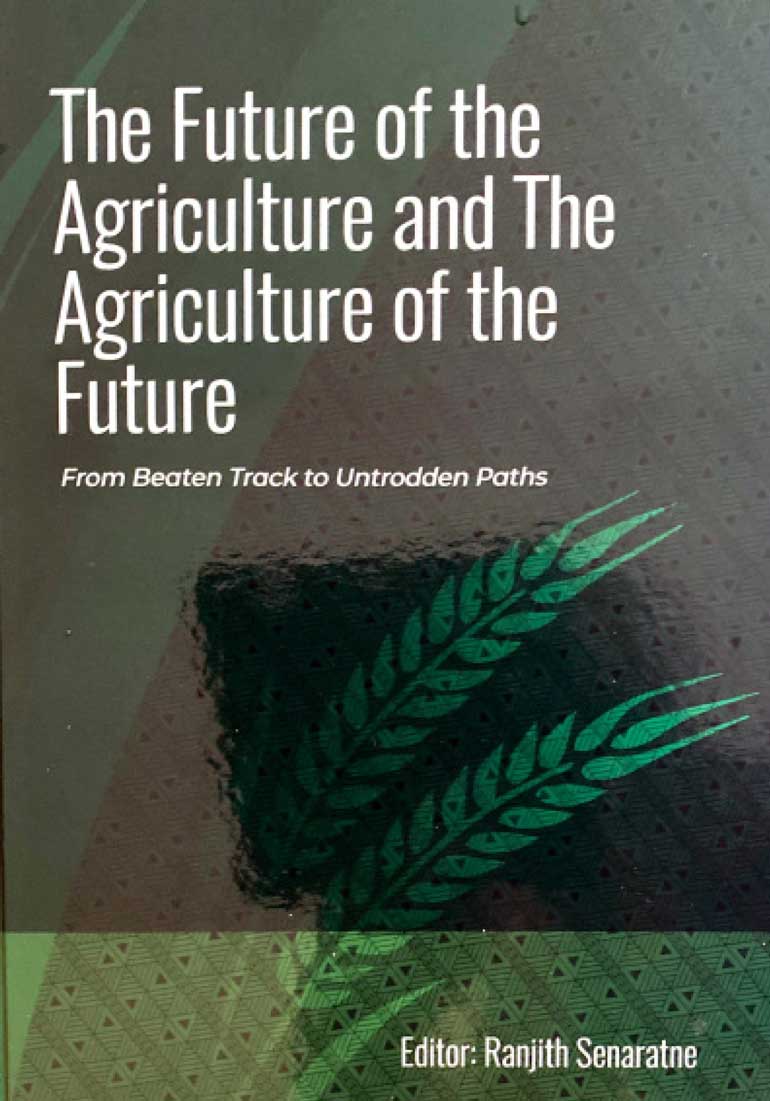Monday Apr 07, 2025
Monday Apr 07, 2025
Monday, 28 February 2022 00:10 - - {{hitsCtrl.values.hits}}

New scholarly work on agriculture
The Emeritus Professor Ranjith Senaratne, formerly Vice Chancellor of the University of Ruhuna and presently Chairperson, National Science Foundation, has just released the third of his edited work under an apt title ‘The Future of the Agriculture and the Agriculture of the Future’. Its subtitle, ‘From Beaten Track to Untrodden Paths’, implies that agriculture, like any other economic activity, should disrupt itself and move into new areas if it is to serve the world’s population at large.
presently Chairperson, National Science Foundation, has just released the third of his edited work under an apt title ‘The Future of the Agriculture and the Agriculture of the Future’. Its subtitle, ‘From Beaten Track to Untrodden Paths’, implies that agriculture, like any other economic activity, should disrupt itself and move into new areas if it is to serve the world’s population at large.
Previously he published a similar edited work on Ceylon Cinnamon (a review could be accessed at: https://www.ft.lk/columns/Can-Sri-Lanka-regain-glory-of-cinnamon-Yes-according-to-Senaratne-and-Pathirana/4-714349) and on what policy strategies Sri Lanka should adopt to get out of the multitude of ailments caused by COVID-19 pandemic (a review could be accessed at: https://www.ft.lk/columns/COVID-19-pandemic-A-brief-to-Sri-Lanka-s-authorities-by-the-scientific-community/4-728945).
While these two works have been team-editions, the latest edition has been completed as a solo work. To accomplish this task, he has got 35 scholars to produce 20 papers on numerous topics in agriculture.
Disrupted agriculture in Sri Lanka
The release of this scholarly work is timely because Sri Lanka’s agriculture has been disrupted by delivering a negative shock to it by the Gotabaya Rajapaksa administration in its attempt at converting it to organic farming overnight. When this was announced in April 2021 in the guise of supplying toxin-free food products to Sri Lankans, 30 agricultural scientists presented a joint memo to the President highlighting its disruptive features and urging the president to defer it or implement it over a period. Prof. Senaratne as a scientist had been the first signatory to this memo (see a review of this memo at https://www.ft.lk/columns/Fertiliser-fiasco-Shouldn-t-the-Government-listen-to-expert-advice/4-719438 ).
Sri Lanka’s agriculture based on decades-long improved varieties that had been introduced local scientists had been fully dependent on chemical fertilisers and pesticides for delivering a high output, a must in a competitive world. When it is denied of essential nutrients by a sudden political decision that had not consulted the scientific community before introducing it, the inevitable result would have been a drop in the output. These scientists had predicted a drop of about 30-50% in the output depending on the type of the crop. This wise counsel was not heeded to, and scientific opinions were not sought. Instead, those who had nothing to do with agriculture or science were the top policy advisors on the new disruptive move. Now Ranjith Senaratne has collected scientists’ views on the development of agriculture, and it should be an essential reading by those who make policies on agriculture in the Gotabaya Rajapaksa administration.
 It should be a new Agri-Culture
It should be a new Agri-Culture
In the Preface to the volume, Senaratne has highlighted that modern agriculture not only feeds the increasing mouths of the globe but also provides numerous inputs to a dozen of other activities such as production of medicines, biofuels, cosmetics, feeds for animals, to mention but a few. But the arable land available for this purpose is limited. When attempts are made to increase the output intensively in the limited arable land space, environmental issues should naturally arise. Hence, the challenge before the modern agriculture, according to Senaratne is to make agriculture ‘more productive, more resource-efficient, more resilient, more environment-friendly, less wasteful and more profitable’.
These are competing goals and to attain them simultaneously agricultural policymakers will have to balance them appropriately. It, says Senaratne, is a new system that can be called Agri-Culture combining the two concepts separately into a new subject matter. The purpose of the present treatise has been to bring out a blueprint of this New Agri-Culture. That is why the book is titled ‘The Future of the Agriculture and the Agriculture of the Future’ implying that they are two separate subjects that should be studied together.
 From conventional to knowledge-based farming
From conventional to knowledge-based farming
In the introduction to the volume, Ranjith Senaratne and Duwini Padukkage have taken the readers through Sri Lanka’s agriculture from a historical perspective and concluded that the future of agriculture depends on the ability of the country to break away from conventional farming to knowledge-based scientific farming. For that, the country needs to make a substantial investment in research and development facilitated by the private sector. The emphasis on the private sector in this conclusion differs from the general belief harboured by many that it is the responsibility of the Government to initiate such research programs.
Contrary to this view, the private sector’s participation in research and development is needed because it will facilitate the commercial production of such research outcomes, a process known in economics as innovation. Thus, in today’s context, research and development should be supplemented by innovation because inventions which researchers would make should be put into practice in the field by entrepreneurs. This has been further analysed by Rizvi Zaheed in his paper on the private sector’s role in technology transfer in agriculture. His conclusion has been that the private sector should be used for this purpose since it has both the capacity and the will to develop technology, adopt it, and facilitate its transfer which is known as diffusion.
Sri Lanka cannot grow everything
Many in Sri Lanka believe that the country should adopt a zero-import policy of foods and Agri-products because they can be produced in the country. This is an extreme version of import substitution. However, the limitations in resource endowments do not permit Sri Lanka to go for this policy target since products like wheat, dhal, certain fruits and vegetables, fish, vegetable oils, and wine cannot be produced in the country. This issue has been analysed by Jeevika Weerahewa, Sumali Dissanayake, and Erandathie Pathiraja in their paper on import of foodstuffs and agricultural raw materials to Sri Lanka.
They have found that despite the massive increase in the trade deficit over the years, the share of foods and beverages in total imports have steadily declined from 70% in 1999 to 30% in 2017. Even then, most of such imports are industry raw materials like wheat. Hence, the claim that Sri Lanka is wasting its forex earnings for importing foodstuffs is an overblown perception.
No direct evidence between pesticides and kidney diseases
The agricultural policy of the present Government is driven by perceived concerns about the adverse health effects of the use of chemical fertilisers and pesticides. As mentioned earlier, the Government has banned the importation of both these inputs, on one side, and promoted the organic farming, on the other, to provide a toxin-free food basket to citizens. A paper by Sudheera Jayasinghe has analysed the health effects of the use of pesticides, while that by Piyasena Abeygunawardena has investigated the potential and the scope of organic farming in Sri Lanka. Sudheera Jayasinghe’s paper has concluded that it is not the use of pesticides per se that will have adverse impact on health but its overuse and misuse.
As a result, these pesticides have reached destinations which have not been intended and generated harmful effects on health and environment. Hence, it is not a reason to go for a total ban of pesticides. The proper education of farmers on the correct use of these essential inputs would have solved the problem. However, there is a wide claim by some that the chronic kidney disease of unknown etiology or CKDu prevalent in the North Central Province in Sri Lanka has been caused by the use of pesticides by farmers.
But Jayasinghe concludes that the present research knowledge does not establish such a direct relationship. There are many other factors that may have contributed to CKDu. Abeygunawardena has concluded that though organic farming has become popular in recent times, it has failed to compete out the traditional farming methods and therefore should be promoted as the only way forward for the agriculture of the future. But this is a very strong conclusion and, given its limitations in output, markets, and scope, it will take a very long time for the global community to reach that target.
Go for crop diversification
Sri Lanka has been successful in becoming self-sufficient in rice requirement by 2010 by using high-yielding varieties, chemical fertilisers, and pesticides. However, one problem faced by agriculturists throughout the globe has been the degradation of the ecosystem due to unplanned use of inputs. Agriculture cannot sustain unless a solution is found to this problem. Ranjith Pathirana and Athula Liyanage have investigated this issue by using case studies from Sri Lanka involving the erosion of crop genetic diversity due to the introduction of high input hybrid planting materials. Their suggestion is that Sri Lanka should use crop and variety diversification as an alternative regenerative food system.
Soil erosion and agriculture
Agriculture which uses natural resources like soil and water abundantly faces a critical problem when it comes to ensuring sustainability because the quality of soil can be degraded, or water resources could dry out with accelerated use of these resources without replenishment. In this context, the issue of soil degradation and how it could be overcome have been investigated by Ranjith B. Mapa, D.B. Wickramasinghe, and H.B. Nayakekorale in a paper titled ‘Threat to Food Production by Soil Degradation and Impoverishment. In common parlance, this is known as soil erosion, but it is caused by both natural reasons and human interventions.
According to the authors, one problem faced by Sri Lanka is the multiplicity of governmental authorities – there are 11 such authorities – charged with the task but functioning without coordination with each other, and hence, become a failure. Consequently, the authors opine, it is time to combine all these authorities and set up a single soil conservation authority to identify the sources of erosion and address them according to the need.
other, and hence, become a failure. Consequently, the authors opine, it is time to combine all these authorities and set up a single soil conservation authority to identify the sources of erosion and address them according to the need.
Water problem in agriculture
The water problem in agriculture is as critical as the problem of soil erosion. This is because the main crop in Sri Lanka, rice farming, is not only a water guzzler but also a crop for which water is overused. I have discussed this issue elsewhere (available at: https://www.ft.lk/columns/Australia-s-rice-miracle-Should-Sri-Lanka-learn-a-lesson-or-two-from-it/4-718904). Arumugam Kandiah and P.B. Dharmasena have investigated the high water use in agriculture amongst competing demands and the ways for coping with the problem.
According to the authors, while rice uses 3,442 litres of water to produce a kilogram of rice, tea uses 7,334 litres, and rubber 18,124 litres. The need for producing more foods to keep the world population fed requires the use of more water in greater volumes. But water is needed by households, industry, and for hydropower generation. When these competing demands are met, there is no sufficient water available for agriculture. Hence, it is necessary to devise methods of efficient use of water in agriculture.
The authors suggest that while improving water productivity, action should be taken to reduce food wastage so that water use in agriculture could be kept at a low level. Writing on the same theme, Asha S. Karunaratne has argued that the use of water and land should be optimised for improving crop productivity and quality.
Produce more with less
The future of agriculture depends on the improvement of productivity and efficiency of resource use to produce more with less. Sri Lanka has already reached this critical level in both subsistence farming involving the production of food crops and commercial agriculture involving the production of exportable crops. There is no unlimited resource availability for any economic activity. A nation which ignores this crucial requirement is to suffer in the long run with declining outputs and incomes of people who are engaged in it. This must be avoided at any cost.
Agriculture of the future: Use digital revolution
The agriculture of the future is therefore dependent on modernising the same on modern lines. This is the second green revolution akin to the fourth industrial revolution in manufacturing. I have analysed this issue in a previous article in this series (available at: https://www.ft.lk/columns/COVID-19-fallout-Support-agriculture-but-not-on-old-lines/4-700650). In this connection, Athula Ginige, Pathirage Samya Dimithrie, Sreenivasulu Midhhe, and Parimal Kumar have presented a blueprint of using digital technology for eco-friendly, resource efficient, knowledge driven agriculture in the future. This is the second green revolution that should be introduced to agriculture.
The possibilities which the authors have suggested are the use of sensors, software, digital connectivity, location tracking, robotics, data analytics, and digital devices in agriculture. One plus point in using digital technology is the decline in the cost of data use when the costs of all other inputs are rising. These high digital technologies can deliver the inputs needed, namely, water, fertilisers, and pesticides more efficiently to plants when they most need such inputs. What this means is that the agriculture of the future is not small-farmer based traditional farming, but smart-farmer based modern farming. This is a must and agricultural policy authorities should prepare the farmers as well as the systems in agriculture to embrace this.
Ranjith Senaratne by editing this volume has opened the eyes of Sri Lanka’s policymakers to new trends in agriculture. In my view, it is a must reading for them.
(The writer, a former Deputy Governor of the Central Bank of Sri Lanka, can be reached at [email protected].)
Discover Kapruka, the leading online shopping platform in Sri Lanka, where you can conveniently send Gifts and Flowers to your loved ones for any event including Valentine ’s Day. Explore a wide range of popular Shopping Categories on Kapruka, including Toys, Groceries, Electronics, Birthday Cakes, Fruits, Chocolates, Flower Bouquets, Clothing, Watches, Lingerie, Gift Sets and Jewellery. Also if you’re interested in selling with Kapruka, Partner Central by Kapruka is the best solution to start with. Moreover, through Kapruka Global Shop, you can also enjoy the convenience of purchasing products from renowned platforms like Amazon and eBay and have them delivered to Sri Lanka.
Discover Kapruka, the leading online shopping platform in Sri Lanka, where you can conveniently send Gifts and Flowers to your loved ones for any event including Valentine ’s Day. Explore a wide range of popular Shopping Categories on Kapruka, including Toys, Groceries, Electronics, Birthday Cakes, Fruits, Chocolates, Flower Bouquets, Clothing, Watches, Lingerie, Gift Sets and Jewellery. Also if you’re interested in selling with Kapruka, Partner Central by Kapruka is the best solution to start with. Moreover, through Kapruka Global Shop, you can also enjoy the convenience of purchasing products from renowned platforms like Amazon and eBay and have them delivered to Sri Lanka.